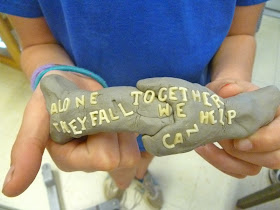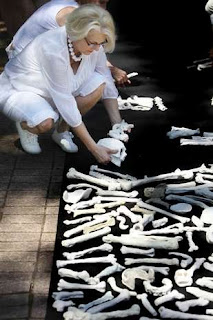Today's post is a first for us here on Murder is Everywhere: it's been written by a guest who doesn't write crime fiction.
Jane McPherson is a doctoral candidate in social work and human rights at Florida State University -- and the principal organizer of One Million Bones Florida. That said, she is no stranger to the community of authors. Jane's father is William McPherson whose novel, Testing the Current was just called “a flawless literary achievement” by The Atlantic Monthly; and her husband, Jon Jefferson, is the writer-half of Jefferson Bass, author of six New York Times best-selling crime novels. She is also fond of the work (and the company) of her two high-school-aged children, Nathaniel and Ursula, who, she assures me, are good writers, too.
The numbers, in brackets, in the text, all refer to links that you can (and should) click on. You'll find them all at the bottom of the page.
What's One Million Bones?
Read on.
Leighton - Monday
Some
murders are just more fun to read about than others. I like to read about murders
in my favorite cities, like Valencia, Spain, and Rio de Janeiro, Brazil. These are exotic murders of bullfighting
stars
(Thank you, Jason Webster, for Or
the Bull Kills You)
or brutal crimes that are resolved by clever kidnapping
victims who steamily sex their captors to death
(Hats off to Luiz Alfredo
Garcia-Roza for Silence of the Rain).
Real
murder—especially the cynical, political slaughter of thousands—is a lot less
entertaining—and yet much more important to understand, to intervene in, and to
prevent. To effectively prevent mass atrocities, we need to know the stories of
men, women and children who are massacred, violated, and displaced in places
like Syria, the Democratic Republic of the Congo, Sudan, and Burma.
This piece[1]
posted by United to End Genocide[2]
gives an overview of world’s atrocities as we came to the end of 2012, but it
focuses on numbers, policies, and geography—we get no narrative, no stories
about individual people who are affected.
One
Million Bones,[3]
a national arts-activism project, endeavors to create emotional, personal
connections between people in powerful countries like the U.S., and the victims
an ocean away.
Here[4]
Naomi Natale, the founding artist of One Million Bones, tells the story of
Ashta, a young mother now living in a refugee camp in Chad.
One
Million Bones engages participants in the fight against genocide and other
human rights abuses with a very simple action:
We make replicas of human bones from clay.
First, through a partnership with Students Rebuild,[5] each bone we make raises $1 (USD) for CARE International’s[6] services to survivors in Congo and Somalia. As of New Year’s Day 2013, we’d made over 450,000 bones—and therefore raised $450,000 for services—with the help of volunteers in all 50 U.S. states and 11 countries. (You can track our progress[1] towards 1,000,000 bones on the Students Rebuild home page.)
Second,
the bones are made to be seen, first in cities and towns where they are made,
and finally, in Washington, DC, on Saturday, June 8th, 2013.
Stunning
videos document the laying down of bones in Albuquerque[2]
and Tallahassee,[3]
but these remarkable installations will be dwarfed by the installation on the National
Mall. Imagine: One million bones.
Mukweso Mwenene[4],
originally from the Democratic Republic of Congo and now living in Tallahassee,
Florida, knows the sight of human bones:
He has seen the evidence of massacres. “But in my country,” he says, “the skeletons are
all in the closet.” Mukweso will
be with us in June when we evoke
an enormous mass grave on the National Mall—a giant petition calling for an end to
genocide through prevention and intervention.
You
should join us, too! We need volunteers to make bones[5],
to organize events[6],
and we need at least 4,000 people to lay 1,000,000
bones on the National Mall. You
can sign up here[7]
to help in DC.
Help us
connect a voice and a story to every clay bone.











Thank you, Jane, for this. We need to be reminded over and over again of these atrocities.
ReplyDeleteStan in South Africa, which has seen its share of genocide, particularly with respect to the San.
Stan, How lovely for me to find your comment on first reading this piece. Thank you. Yes, atrocities--and their victims--are important. I read a lovely bit in yesterday's New York Times paraphrasing a paraphrasing something a clergyman had said after 9/11: "it is to overwhelming to think of...3,000 people dead. The best way to honor [the victims] was to think that 'one person died' three thousand times." This, I believe, is how we must think of the victims of genocide and mass violence.
Delete"The best way to honor [the victims] was to think that 'one person died' three thousand times."
DeleteThank you for that, Jane, and for your very moving post.
It is always so easy to ask for the worst for the perpetrators. South Africa's Truth and Reconciliation Commission was one of the most heart wrenching events of my life - hearing people confess to their atrocities and then be publicly forgiven by the families of the victims. There is a lesson to be learnt there.
ReplyDeleteYes, indeed.
DeleteMy hat is off to you, Jane, for being involved in a project that gives the many, many people of good will sickened by these ongoing atrocities a means for demonstrating their feelings in a personal, in-your-face manner to the world.
ReplyDeleteThanks so much, Jeffrey. Please come join us in DC--or donate and learn more at www.onemillionbones.org
DeleteDonating is no problem, Jane, but I'll be back in Greece in June working on the next book. Thanks for the invitation though.
DeleteAmazing idea. Much credit to all involved.
ReplyDeleteThere really are amazing people around the world involved in this project. Thanks for your support.
Delete